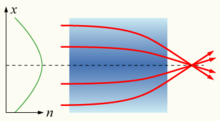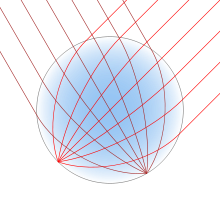Gradient optics
The gradient optical is the part of the field of optics , of the behavior of light in materials having a gradient of refractive index describes. In such materials, a light beam is deflected in an arc shape depending on the angle of incidence .
Angle of distraction
When a light beam passes between two materials with different refractive indices, its direction of propagation changes according to Snellius' law of refraction . This also applies if the transition in the refractive index does not take place abruptly, but rather gradually. The same applies to the angle of incidence from which total reflection occurs.
Gradient lenses
The optical properties of continuous material transitions are including in gradient lenses ( GRIN - / Gr adienten- In use dex lenses). These are cylindrical , transparent optical components with a refractive index that decreases in the radial direction. Usually the refractive index decreases quadratically with the distance to the center ( parabolic function ). A short rod made of such a material acts like an ordinary converging lens , but has flat surfaces on the light entry and exit sides. This facilitates assembly , miniaturization and the connection with subsequent optical elements. The flat surface of such lenses is an advantage over conventional lenses, especially when coupled to optical waveguides . GRIN lenses are often used in applications that require numerous optical elements in a small space. Examples are photocopiers or scanners .
In contrast to the shape of ground lenses, the radial refractive index curve can hardly be influenced in detail during manufacture. In addition, there is no economical manufacturing process for large lens diameters. GRIN lenses are therefore less suitable for optical systems with high optical resolution, for example in the lens (optics) of a camera. However, a multi-layered structure made of different plastics can bring about progress.
In neuroscience, GRIN lenses are used to measure calcium signals in nerve cells located deep below the surface of the brain. It is thus possible to examine brain regions in the living organism that were inaccessible to conventional in vivo microscopy methods, such as the two photon technique .
The most common manufacturing method for glass GRIN lenses is ion exchange . For example, sodium-containing glass can be immersed in liquid lithium . Some of the Na + ions in the glass are exchanged for Li + ions by diffusion , with the resulting lithium content being higher on the surface than in the depth of the material. Thus, after the treatment, the glass has a material gradient and a corresponding gradient of the refractive index.
Gradient Index Fibers
Certain optical waveguides, called gradient index fibers, have a refractive index that gradually decreases radially outwards. In the case of multimode fibers , this has the advantage that the dispersion of different modes is less than in the case of a refractive index increasing in steps.
Further examples
A common example of a gradient optical effect is the mirage . A shimmering reflection of the sky can be seen at a greater distance over the asphalt of a road heated by the sun. The reason for this is that hot air just above the road surface has a lower refractive index than cooler and therefore denser air above. This refractive index gradient directs light falling at a shallow angle onto the road surface in an arc shape back up and into the eye of the beholder.
The lens of the human eye has a radially decreasing index of refraction. Together effected with the lens shape this a focus of the incident light to the retina .
The stratification of the atmosphere partly directs radio waves back to earth. In this way they reach places beyond the horizon and overreaches arise .
With the Lüneburg lens , the refractive index of a transparent sphere increases from the outside to the inside. Incident, plane wave fronts are thereby focused on the surface of the back of the sphere. This makes the ball act like a cat's eye .
See also
literature
- Bernhard Messerschmidt :: Gradient optics - an innovative micro-optics for optoelectronics and medical image acquisition. In: Photonics . No. 6 , 2003, p. 54 .
- Bernhard Messerschmidt: Gradient optics - innovative micro-optics for laser diode beam shaping and sensors . In: Laser Technik Journal . tape 2 , no. 3 , September 2005, pp. 47–50 , doi : 10.1002 / latj.200790054 .
Individual evidence
- ↑ Grintech (Ed.): Gradient Index (GRIN) Lenses . 2009, Retrieved October 3, 2009.
- ↑ JS Shirk et al .: Biomimetic Gradient Index (GRIN) Lenses (PDF; 502 kB), NRL REVIEW, 2006.
- ↑ Kunal K Ghosh, Laurie D Burns, Eric D Cocker, Axel Nimmerjahn, Yaniv Ziv: Miniaturized integration of a fluorescence microscope . In: Nature Methods . tape 8 , no. October 10 , 2011, ISSN 1548-7105 , p. 871–878 , doi : 10.1038 / nmeth.1694 ( nature.com [accessed March 18, 2018]).



